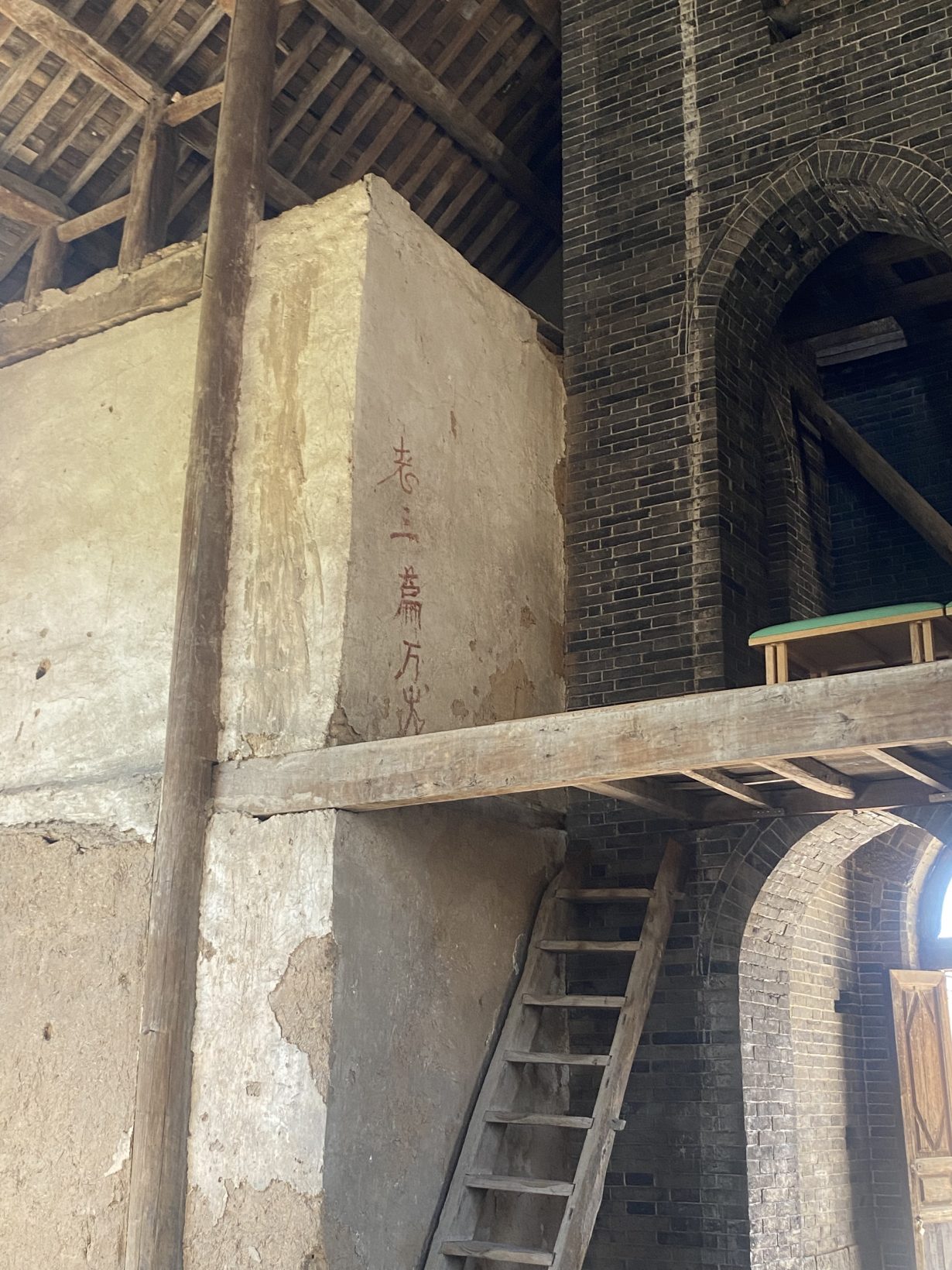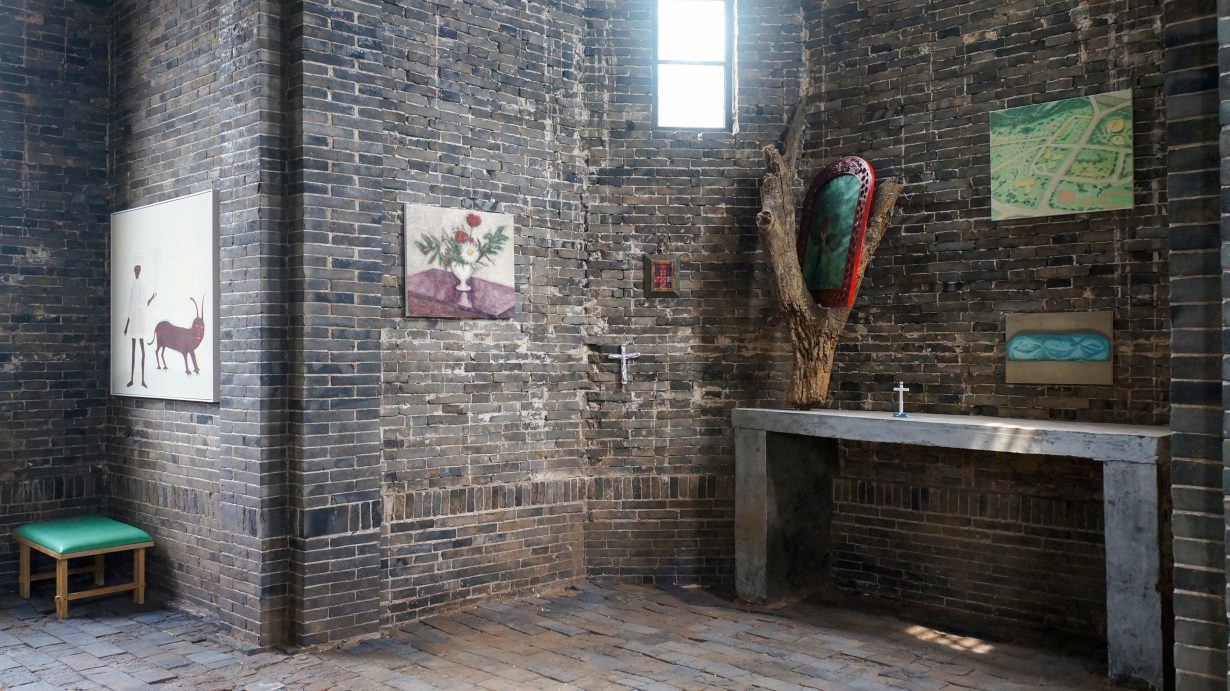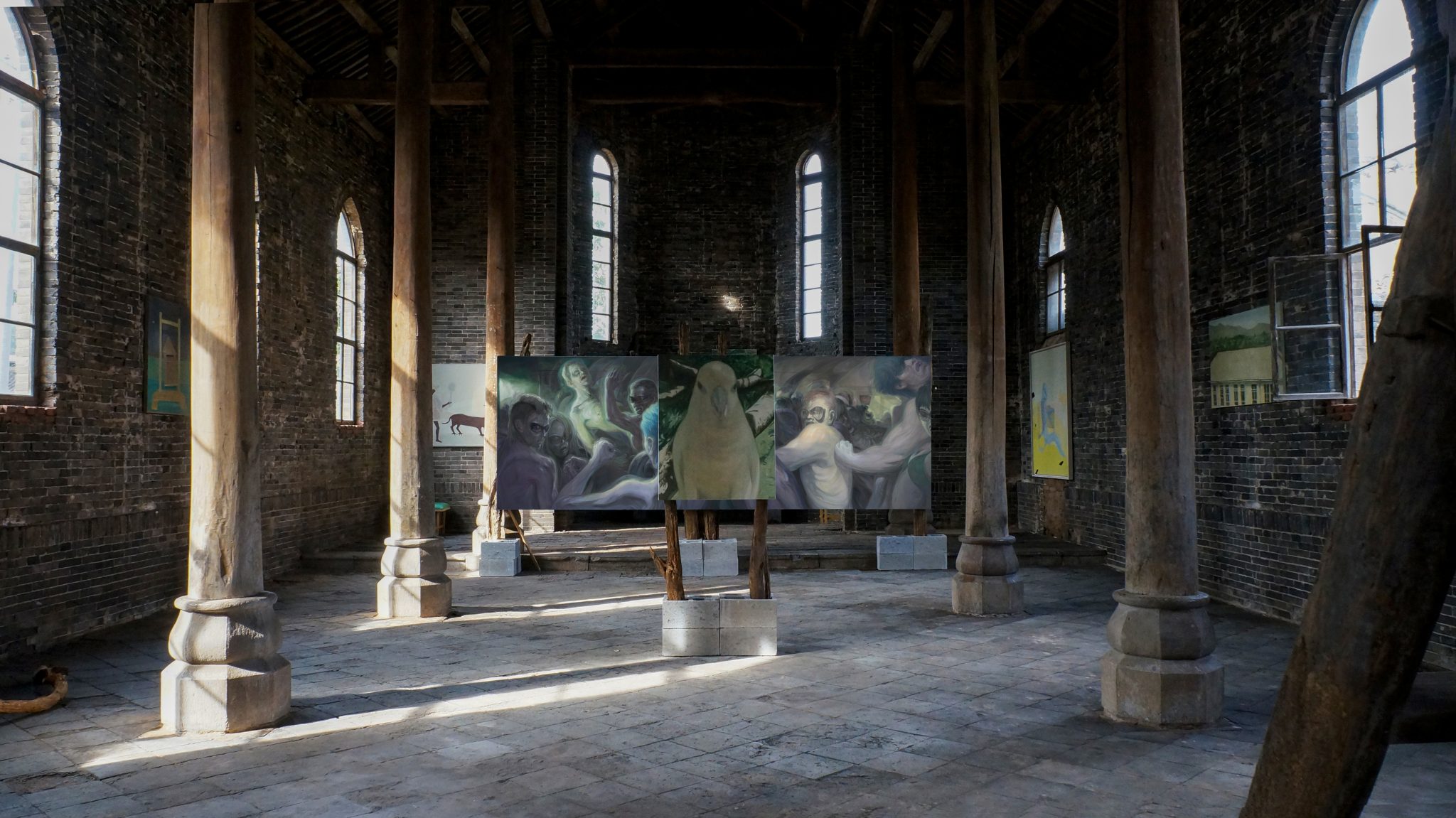Yuwen Jiang wonders why she’s going to church to find out
Hunsand Space’s new gallery is a remarkable place in an unremarkable location: a formerly abandoned (now restored) Catholic chapel in Beizhangcheng, Jingxing County, Hebei Province. It nestles among the village’s narrow alleyways and courtyard houses, and amid the sounds of the clucking chickens and baaing sheep that occupy its dilapidated, rubbish-filled backyard. The village is poor, and not the type of location in which you’d expect to find a commercial art gallery. Architecturally, the building is integrated with its surroundings: it’s built using familiar blue clay bricks; inside, a simple nave leads to a small altar, under a ceiling constructed of wood beams with interlocking joints that are also characteristic of traditional Chinese carpentry. On the map, the chapel is named ‘The Catholic Chapel’ – it’s perhaps appropriate then that the gallery’s inaugural exhibition is also functionally titled The Opening Exhibition.
A gallery text tells us that the works on view were selected ‘in order to gradually build a connection’ to the space’s general atmosphere. On entering, you’re confronted by Hidetaka Suzuki’s painting Steal Your Voice (2020), which features a menacing parrot. Staring out at us, the bird looks almost demonic, as if declaring the now defunct chapel to be in its possession. In keeping with that, it blocks your view of the nave. Once you get round that, you will find a series of paintings and sculptures by various artists placed around or hung on the chapel’s brick walls. They feature witches, bestiaries, underground raves, fetishistic leather objects and various forms of crucifixes. A sequence of Suzuki’s paintings of farmed fields, village houses and rice sacks is arranged in between. The whole, meanwhile, sits under the pale dappled light entering through the elongated church windows. Like the setting, what we’re presented with is a mixture of the fantastic and the mundane, the sacrilegious and the homely. Neither so Catholic nor so Chinese, it’s a rich but surreal aesthetic experience.

Despite its presence amid the village buildings, local residents don’t seem particularly interested in the former church – or the artistic identity it has acquired under Hunsand Space. As I walked around, the only villagers I saw were people filling their water tanks in the alleyway. Water is only available each day around noon, I was told by the gallery staff (which, incidentally, made renovation really hard). Those who do visit tend to be those who had known the gallery at its previous location, in Shijiazhuang, or occasionally, people who come across the exotic space on the internet and swing by to take Xiaohongshu-worthy pictures, then head back to the city or continue their daytrip to the mountains. Coming from Beijing just after its Gallery Weekend, I felt morally obligated to reflect on my position: consuming the art that was presented to me, while knowing it was avoided by the locals. In a sense art feels irrelevant and out of place here, and the chapel-turned-gallery, and I, are something like colonists. Perhaps even more so than the Catholics once were.
Jingxing is located in the middle of the Taihang Mountains, where streams and valley breezes cool the air in the summer, and ‘scorching days remain no longer than a few days’, according to a local record written in 1931 and published in 1934. It is today part of the Roman Catholic Diocese of Zhengding, which encompasses a region surrounding today’s Shijiazhuang, capital of Hebei Province. Despite the region continuing to be a Catholic hub even after Qing Emperor Yongzheng’s ban on Catholicism drove devotees out of Beijing in 1724, Jingxing stayed immune to the waves of religious migration well into the second decade of the twentieth century. (During this last period of time, rioters of the anti-imperial, anti-Christian Boxer Rebellion, 1899–1901, roamed northern China; the Qing dynasty collapsed in 1911; and during the first eight years of the ensuing Republic of China, protestant missionaries from France and England were able to convert no more than 30 of Jingxing’s people.) In 1920, a major drought hit the region’s harvests, causing famine. Per the same county records, missionaries from the Catholic and Protestant churches were ordered to bring disaster relief: the Protestant missionaries gave food freely, regardless of affiliation; the Catholic Church prioritised its own converts.

This is around the time when Beizhangcheng’s chapel is thought to have been built. By 1930, there were 673 Catholics and 52 Protestants in Jingxing. But they quickly dispersed, which might also reveal the true reasons for their original conversion: they needed food. After the chapel fell out of use (it is unclear when), it was converted first to a school, then to a storage space. On one side of the wall is clumsily graffitied ‘long live laosanpian’ – a Cultural Revolution-era slogan referring to three texts written by Mao Zedong before the founding of the People’s Republic in 1949 – the revolutionary frenzy of which must have trumped the shortlived Catholic mania of the 1920s.
This is not to say that the chapel’s own history should be the only way for the gallery to engage and build connections within its local context. But it’s hard not to question what role the gallery plays in the local cultural scene and to wonder how art can create dialogues with a nonartistic public, in a place far away from urban centres – and in a way that doesn’t entirely fall prey to art’s capitalist, consumerist logic. (For a local example of that, look no further than Hebei’s cultural hub Aranya, developed by a real-estate company in 2013 and now hosting the UCCA Dune as well as Aranya Art Center.)

From artists and curators working in China’s countryside such as Zuo Jing, initiator of The Bishan Project in Anhui, and Mia Yu, who has been devoting her time recently to researching the postindustrial heritage in Fushun – a town in China’s northeastern Rust Belt – we learn that in places that are culturally deprived, artistic interventions are more welcomed than shunned by members of local communities. Although it can take time to truly connect. By bridging art and local customs, initiating education projects and incorporating local communities in the daily running of cultural spaces, Zuo in particular has explored how long-term artistic interventions can mobilise local residents and reactivate rural public life, while also preventing the countryside from being reduced to a tourist attraction or swallowed up or hollowed out by waves of urbanisation.
‘Every time I come to Beizhangcheng Village where the church is located, these curatorial plans and concepts seem contrived and pale in front of this ancient village,’ the founder of Hunsand Space writes in a gallery statement. ‘That kind of natural, primitive health and vitality is unforgettable, and it slowly dissolves our slightly detached cultural imagination of this space.’ It is indeed invigorating when the gallery sees the significance embodied in a piece of Catholic architecture – a heritage that’s often neglected in the official narrative of China’s cultural revival of mostly Han traditions – and faithfully restores it. The result is much more carefully done than many publicly funded renovation projects (such as, for example, the renovation of Beijing’s hutongs in 2019). And there’s no doubt that the immediacy of local features must have been inspiring for a gallery that’s aesthetically finetuned. But the question for Hunsand Space – along with myriad rural investments by China’s artworld – is how these spaces can both be inspired by and serve their locations.
